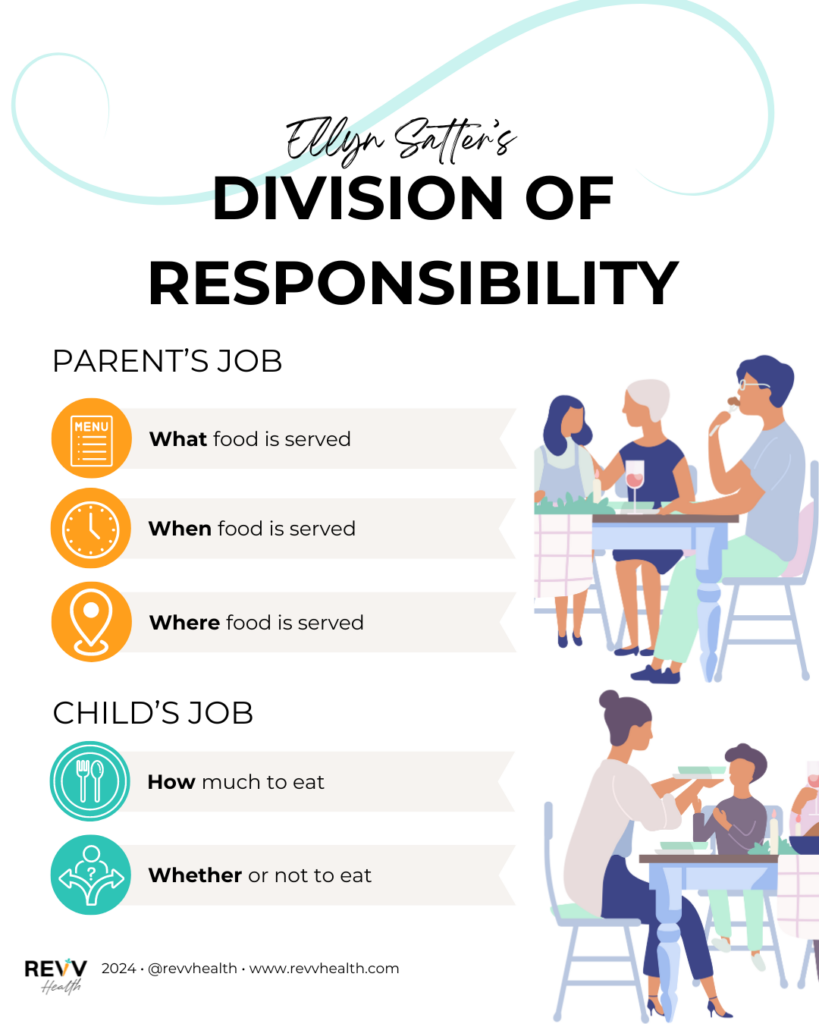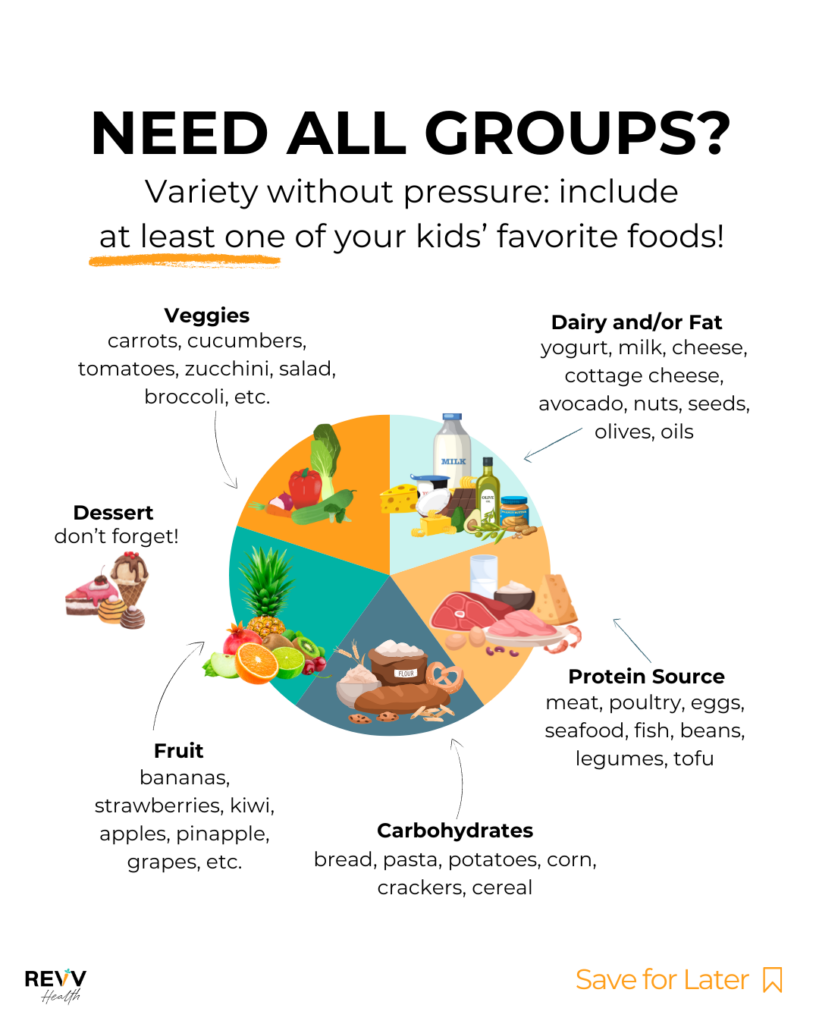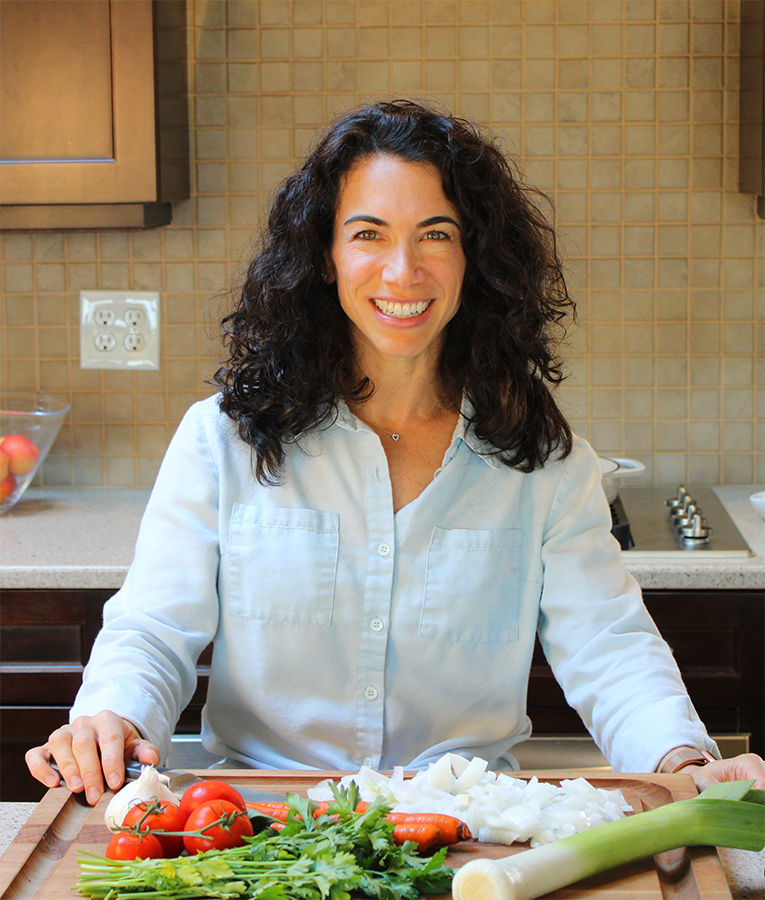Does dinnertime feel like watching a high-stakes football game where you’re following along with each bite, grimace, and fit that your child has at the dinner table? Your heart is pounding, your frustration is through the roof and your patience has officially run out.
Feeding kids is not for the faint of heart. But it also doesn’t have to be a daily battle.
Whether you’re a new parent seeking nutrition guidance or a seasoned caregiver struggling with picky eating, the Ellyn Satter Division of Responsibility is a feeding model that might be just the tool you and your family are missing.
Hi there! I’m Marissa, a family nutrition expert, corporate wellness dietitian, and mom to two girls. I love helping real parents like you with real nutrition guidance that meshes well with your busy lives without sacrificing your health goals – or sanity.
In this article, I am going to break down everything you need to know about Ellyn Satter’s Division of Responsibility and how to successfully use it within your own home, starting today. My hope is that you’ll feel confident not only in what you feed your kids – but also in how.
Let’s start things off with an introduction to Ellyn Satter and her strategies that actually make dinnertime better.
Listen to this article:
What is Ellyn Satter’s Division of Responsibility in feeding?
If I could invite anyone over to dinner it might just be Ellyn Satter, MS, MSSW – I admire her teachings so much.
Ellyn is the superhero who came up with The Division of Responsibility. Ellyn is both a dietitian and family therapist, and her teachings are recognized by leading pediatric and nutrition associations as a best feeding practice for babies and kids of all ages.
The main goal in using the Division of Responsibility is to develop a sense of trust between parents and children with food.
As Satter states,
“When parents do their jobs with feeding, children do their jobs with eating” (1).
– Ellyn Satter, MS, MSSW
So how does it all work?
Let me first tell you what the Division of Responsibility is NOT.
Helping your kiddo to be a more adventurous eater is NOT about forcing them to try one more bite or losing your cool and hollering through dinner. Hey, if that worked, you wouldn’t be seeking this article, right?
Instead, Satter offers a framework (that really works) so that you no longer need to micromanage your child’s every bite.
With Satter’s Division of Responsibility, you’re not actually in charge of deciding how much your child eats at any given meal (gasp, right?). Instead, you’re creating an environment where your child can better listen to their own body and eat the right amount for them.
The parent’s responsibilities are:
- What to feed
- When to feed
- Where to feed
The child’s responsibilities are:
- How much to eat of the foods being served
- Whether or not to eat at all
This means: you no longer need to follow along and coax your child to eat every single bite. What a relief, right? I promise it isn’t a fantasy – with practice, your meals can become far more peaceful.
Even if you haven’t started with this approach from the beginning with your toddler or newborn, it’s still worth working on.
What is the reason to use this feeding approach?
The entire goal of the Ellyn Satter Division of Responsibility is to help your children become competent eaters, where they develop a lifelong healthy relationship with food and enjoy eating the food your family serves.
What does being a “competent eater” mean? According to Satter, both competent eating adults and kids feel relaxed around food, listen to their bodies to eat the right amount that is unique to them at that particular time — and are willing to try new foods.
This feeding approach respects the natural capabilities of your little humans. They already know how to listen to their bodies if we only let them do so! But if you grew up in a “clean plate” household, this approach could feel pretty foreign.
In my work with clients, I’ve observed that when parents establish clear roles for themselves and their kids, the Division of Responsibility can produce several positive outcomes:
1. It can foster trust.
- Parents: have confidence that their children will develop in their unique way.
- Children: feel assured that they can explore new foods at their own pace.
2. It can prevent power struggles.
- Parents: can stick with their designated roles, which minimizes conflicts at mealtime.
- Children: are freed from pressure, and don’t feel obligated to consume specific amounts or types of food.
3. It can promote autonomy.
- Parents: realize they do not have to control every aspect of feeding their children.
- Children: develop the autonomy to make choices aligned with their hunger and fullness cues.
4. It can encourage healthy eating habits.
- Parents: serve as role models and expose kids to a variety of nutrients.
- Children: are encouraged to explore various foods and learn to appreciate different flavors.
5. It can support positive eating experiences.
- Parents: create a positive feeding environment, which enhances enjoyment at mealtimes and reduces stress associated with food.
- Children: become open to trying new things, which leads to positive eating experiences for them.
But what if this is the first time you’re learning about the Division of Responsibility – can this even work in your family?
Where do I begin?
If you are wondering where to begin with the Ellyn Satter Division of Responsibility, especially if you’re new to it or feeling discouraged because you haven’t been doing this, here are your first steps. Making a change in your home is possible and will be worth it once you get the hang of it!
First, take a step back, and get curious.
Are you…
- Pressuring your kids to finish everything on their plates?
- Rewarding or punishing them based on their eating habits?
- Dictating the exact portion sizes they should consume?
- Insisting on a certain number of bites before leaving the table?
Are your kids…
- Having unrestricted access to the food in your house?
- Eating wherever or whenever they want?
- Being asked what they want to eat for most meals and snacks?
- Ignoring mealtime routines?
Here’s the thing: you can’t make effective goals or plans if you don’t have a good understanding of where you are and what’s happening in your home, right now.
By reflecting on what is happening, you can begin the self-awareness needed to lay the groundwork for adopting the Ellyn Satter Division of Responsibility.
Toward the end of this article, I have prepared a short quiz to help you determine where you are in the process so that you can start this practice wherever you are in your journey.
As you make gradual changes, rest assured, you will be creating a positive and relaxed atmosphere around meals for both you and your children!
Does the Division of Responsibility apply to kids of all ages?
Children from infancy through adolescence can benefit from this feeding approach.
Let’s break down how you can use the Ellyn Satter Division of Responsibility based on the ages of your children.
Starting with infants
You can use the Division of Responsibility right away!
- The parent is responsible for choosing breastmilk and/or formula and tuning into the child’s cues about when, how fast, and how much they want to eat.
- The child is responsible for everything else (this means when, where and how much)
Parents of babies
At the start of a child’s introduction to solid food, parents can begin to take on more roles.
- The parent is still responsible for what to feed but is now becoming more responsible for when and where. This is because as a child grows, the transition toward a structured feeding schedule doesn’t happen overnight.
- The child continues to be responsible for how much and whether to eat from the solid foods and milk offered by the parents.
Are you uncertain about when to introduce solid foods?
If so, explore my colleague Katie Ferraro’s blog and resources for guidance on finding the perfect timing for your baby using the Baby Led Weaning (BLW) strategy.
I have personally benefited from her “100 Foods Before the Age of One” list and used her strategies to expose my girls to a diverse range of foods when they were babies. I feel so grateful for her impactful work.
Parents of toddlers
Toddlers are either in daycare or with their parents or caregivers during the day. Now is a great time to establish more structure.
- The parent is responsible for what, when and where to feed.
- The child is responsible for how much and whether to eat.
Some tips:
- At this age, it is normal for kids to consume a meal or snack every 2-3 hours.
- Trust your child’s capacity to learn to eat new foods.
- As toddlers begin to become more self-aware, they might start not liking a lot of foods that they used to enjoy – this is completely normal.
- Cook together!
- Use process-oriented language, such as:
- “You are learning to taste new foods” is more helpful than “you don’t like that”
- “Everyone learns to try new foods” instead of “you’re a picky eater”
- Make mealtime a pleasant time. Have them sit at the table during meals and snacks even if they choose not to eat, and converse with them about fun topics (other than food).
- Toddlers are exploratory – give them the chance to learn about food in other sensory ways besides taste (e.g., touching, mushing, smelling, looking and yes – spitting it out if they don’t like it).
- Encourage your toddler to be respectful at mealtimes (e.g., no throwing food, saying no thank you versus yuck, and helping with the cleanup).
The big picture here is that a healthy child isn’t just provided with the right nutrients to grow. Like a garden, a child needs to be nourished in an environment that supports growth beyond the nutrients.
Parents of elementary-aged children
Children thrive nutritionally when parents lead with a structured schedule of feeding and offer a menu that continues to expose a wide variety of foods.
- The parent is responsible for what, when and where to feed.
- The child is responsible for how much and whether to eat at all.
At this age, children should aim to consume food every 3-4 hours, which shakes out to having three meals and about 2-3 snacks per day, depending on activities and their schedules.
Some tips:
- Continue to cook together to help kids learn to like new foods!
- Think about how to create deconstructed dinners that the whole family can enjoy.
- Create balanced meals that include protein, carbohydrates, produce and dairy – remember, kids don’t have to eat all their food groups at every meal and snack! [See the image about that below].
- If you are making lunch from home, I encourage you to prepare what your kids will eat, not what you want them to eat, as they might not get a lot of time during the day to eat their lunch.
- After-school snacks are a great time to expose new foods and prepare energizing combos for sports or activities.
- If possible, eat dinners together as a family to help create a positive environment at the table and learn about everyone’s day.
- Dinner is also a great time to play trivia or verbal games at the table – making it fun to be together and keeping the pressure off the food.
Parents of adolescents
The Division of Responsibility adjusts to the changing needs and independence of adolescents.
It continues to promote a healthy attitude toward food, encourages autonomy in nutritional decision-making, and helps prevent potential issues like disordered eating and eating disorders.
Even though they are older, adolescents still benefit from a supportive feeding environment that is organized and has clear and loving limitations.
Therefore:
- The parent is still responsible for what, when, and where to serve food.
- The adolescent child continues to be responsible for how much, whether to eat, and may start becoming responsible with the menu, timing, and place, depending upon their maturity level.
Some tips:
- Your adolescent might be ready to shop for, prepare and cook meals with your help.
- By now, your kids likely know their way around the kitchen – which is great! But for this reason, it’s okay to remind them to listen to their bodies and avoid grazing so that they can feel hungry enough to eat at scheduled family mealtimes.
- Adolescents are keenly aware of their growing and changing bodies – mealtimes should be free of scrutiny regarding anyone’s plates and/or body sizes.
Menu planning tips: emphasizing preferences
A lot of times, parents struggle with the Division of Responsibility because they mistakenly believe that each child in the family must have all the food groups at every meal.
A better way to wrap your head around meal planning is to look at your role as, “someone who serves.”
You are serving the family most of the food groups at most meals and snacks, but they are deciding how much or whether to eat from the foods being offered.
You guessed it – this might mean that someone goes without eating protein one meal, and another meal, they don’t eat any veggies.
Does this mean they aren’t getting good nutrition?
No.
Instead of zeroing in on every meal and worrying about its balance, I recommend that you take a wider view. Nutrient intake is assessed over the course of a week, considering a variety of meals and snacks.
The main tip is to ensure that there is at least one food group that each child likes to eat at every meal and snack but try not to obsess if you notice that they don’t touch their eggs, or they haven’t had a bite of the fruit.
Over time, children need multiple opportunities to be exposed to foods in a no-pressure setting to improve their food acceptance (2). If you’re forcing your child to take bites, it is going to backfire.
Continue to create your menu by emphasizing all of the food groups, as outlined in the Harvard Healthy Eating Plate. But remember – you are simply acting “as a server,” versus someone who enforces that each food group be eaten at all meals.
How do you deal with dessert?
Ellyn Satter suggests offering dessert in one serving either alongside the meal or at the meal’s end.
The important part is that there are no expectations tied to specific foods (like veggies!) that must be consumed to earn dessert.
This is how we “neutralize” foods in order to create a positive relationship with sweet treats, so that our kids grow up with the idea that all foods can fit into a healthy diet.
So your goal is to introduce dessert as a normal part of the meal, allowing children to enjoy it without any strings attached.
Do you have to offer dessert every day? That’s a family preference and given that you are the one responsible for the menu, that is up to you.
I will say though that when families begin to offer dessert more often than not, they do see a positive benefit associated with their kids feeling like dessert is no longer restricted.
This can help kids develop a healthier relationship with food, as they learn to enjoy treats rather than seeing them as forbidden.
Some families I work with offer dessert daily to emphasize that all foods can fit into a healthy diet. Other families decide to randomly offer dessert. There isn’t a right or wrong here, so long as you are not making negative associations about anyone eating the dessert.
The bottom line is not to dismiss your family’s love of dessert—instead, the goal is to not enforce the perception that dessert is earned only when specific foods are being eaten.
My kids are older: would this still work?
If your kids are older, you might be wondering if Ellyn Satter’s Division of Responsibility is still relevant.
The answer is a BIG yes.
Adolescents crave autonomy!
The Division of Responsibility is all about autonomy. It allows adolescents to make choices about how much to eat and as they mature, they can even be involved in what, when and where, which are skills that prepare them to live independently.
Adolescents are also at a stage where they want to seek more control over their lives.
The Division of Responsibility respects their individual appetites and allows them to tap into their own internal cues.
As teens continue to develop, keeping the structure of family meals remains a valuable way to stay connected. The Division of Responsibility supports this tradition, where adolescents can freely share their experiences without the pressure of parental nagging about food.
It is never too late to help your kids develop a positive relationship with food. You can start to help them at any age.
If you want to start the Division of Responsibility with your adolescent, I highly recommend you sit down away from the table to discuss what you learned about the roles of the parent and the child.
Remember, you are trying to establish trust with your kids, and sitting them down to talk about what you learned is the way in.
Here are some casual scripts you can test out:
- “We learned parents and kids have different jobs when it comes to family meals…”
- “We realized we’ve been doing a job that only you can handle, which is listening to your own body about how much to eat.”
- “Your body knows when it’s hungry and full, and we’re stepping back from interfering.”
- “Since this is new for us, feel free to call us out if we slip up.”
- “We are going to work on developing a menu that includes foods everyone likes, but that also isn’t going to be different for every member of the family.”
- “We do ask that you join us for family meals, and we’ll make sure to respect ‘your no,’ so that we can all enjoy our time together at the table without any food-nagging.”
When to be flexible with the Ellyn Satter Division of Responsibility
If you find it overwhelming or view this feeding practice as just another set of food rules, remember that perfection is not the goal.
In fact, many professionals, including dietitians like me, face similar challenges in implementing this approach in our own homes because we do not want to follow strict food rules.
Personally, I’ve used the Ellyn Satter Division of Responsibility since my kids were born, having studied it well before meeting my husband.
Even for someone with a professional background, it is not always easy. The real challenge arises when your expectations about your kids’ preferences don’t align with reality.
In those moments, it’s okay to “fudge” the Division of Responsibility a bit.
As an example, on a recent podcast of “the Messy Intersection,” a colleague and dietitian, Diana Rice, delves into how dietitians navigate this approach in their own households.
Just like the others interviewed on the podcast, I’ve found myself adjusting, particularly in terms of “the what and when” of feeding.
As an example, sometimes breakfasts may vary for my family, or I might offer a meal or snack sooner than planned.
Flexibility in these situations ensures a more realistic and sustainable application of the Division of Responsibility. When we have a guideline that we follow and adjust to fit our lifestyles, that is when we know we’re managing it in the best way for ourselves and our families.
How does the Division of Responsibility unfold in a real-life scenario?
Picture your kids at the table, and one of them says something like, “I don’t want this food.”
In your head, you might be thinking:
- “They enjoyed that same dish just last week!”
- “I guess I can always offer yogurt after the meal.”
- “The whining is pretty annoying.”
- “I should just give them something else.”
Despite these thoughts, focus on your goal.
You want your kids to develop an enjoyment for the food your family serves and listen to their bodies.
To achieve this, include at least one food group they will eat alongside the foods they are gradually warming up to.
So instead of actioning out what’s in your head, you can instead respond with something like:
- “I get it. This wasn’t what you were expecting tonight.”
- “Since our taste buds are always changing, I thought I’d include these new foods, just in case today is the day.”
- “I don’t have another option right now, but – it is up to you if you want to eat any of the foods I served here.”
- “You are free to decide how much you want to eat from this food.”
- “I know you want something else AND we can have that another time.”
- “Be sure to listen to your body, because after this meal we are going to brush our teeth and start bedtime.”
If a child is verbal, it can be helpful to ask what your kids did not like about the food. If a child struggles to express themselves, discussing preferences in the heat of the moment might not work. Wait until they calm down and talk about the food in a non-judgmental way.
Who shouldn’t use the Ellyn Satter Division of Responsibility?
While this feeding practice benefits most families, there are situations that require highly individualized feeding therapies.
For example:
- Medical conditions: children who have eating disorders, gastrointestinal distress and swallowing complications might need tailored feeding therapies.
- Severe sensory issues: while the Ellyn Satter Division of Responsibility can work beautifully with sensory concerns, parents might need additional support to enact the division effectively as well as participation in additional therapeutic interventions.
- Extreme socio-economic challenges: food insecurity might make it difficult for families to follow this feeding practice due to concerns about potential food waste.
- Special needs: children with specific developmental or cognitive special needs might benefit from a more individualized approach to accommodate their unique feeding requirements.
Your pediatrician, dietitian, or specialist can provide personalized guidance to help you decide which feeding therapy and practice is right for your family.
What if my partner isn’t on board?
I get this question a lot. And it also applies to other members of the family, caregivers and even schools or daycares. But let’s focus on your spouse.
What if two parents can’t agree on how to feed their children?
Perhaps one parent was raised with the “clean plate club” mentality, while the other is open to exploring Ellyn Satter’s approach.
As a family dietitian, I’ve seen this dynamic play out many times. But here’s the good news: there are ways to navigate through it together.
First off, talk it out.
Have an honest conversation about what each of you believes when it comes to feeding your kids. Listen to each other without judgment and try to understand where you’re both coming from.
Next, educate each other.
Share what you know about different feeding approaches and the reasons behind them. Maybe even dive into some research together. This blog post is a great start!
Then, find some middle ground.
Where can you compromise and blend your approaches?
As an example, if one partner values minimizing food waste, while the other wants to explore sensory play with food, there can still be a way to be mindful of both.
This might entail using food items that are nearing their expiration date or leftovers from previous meals for sensory play activities.
The goal is to find a middle ground that respects both partners’ values and priorities.
If things still feel tricky, don’t hesitate to seek professional help. A family therapist or a registered dietitian nutritionist like me can offer guidance and support.
And lastly…
Try to lead by example.
Show your kids what it means to eat a variety of foods, in a relaxed and positive way, and in the quantities that are right for your body. Kids are always watching and will follow what they see.
Final thoughts: what do children really need to eat healthfully?
With an effective feeding strategy that is full of love with limits, children have the innate ability to self-regulate their food intake and develop healthy eating habits that can last a lifetime!
When parents practice the Ellyn Satter Division of Responsibility in feeding, they teach their children how to listen to their hunger and fullness cues while enjoying the meals they are provided. Simultaneously, a child will thrive and develop appropriately in whatever way they are meant to.
Are your feeding techniques aligned with the Ellyn Satter Division of Responsibility?
There is an easy way to find out! Take this quick 3-minute quiz, inspired by Ellyn Satter’s teachings, to discover your current approach and receive tailored guidance on your next steps.









0 Comments